calsfoundation@cals.org
Walnut Grove (Independence County)
The Walnut Grove Cemetery on Walden Road just north of Cord (Independence County) is all that is left of the historically important community of Walnut Grove, located on the Jackson Military Road (named for President Andrew Jackson) built parallel to the old Southwest Trail in the early 1830s. A main road ran nearby from the county seat of Batesville (Independence County) to Elgin (Jackson County), seven miles southeast, where a ferry crossed Black River. Before it was called Walnut Grove, the area was referred to on the census reports as Black River Township.
The Military Road then ran through Hazel Grove (Independence County) to Walnut Grove along Curia Creek, where the marker is located today at the entrance to the cemetery. A historic marker placed at the entrance to the Walnut Grove Cemetery in 2005 relates how David Hogan brought his family to Walnut Grove from North Carolina in 1830; he and three of his children are buried here. Nearby Charlotte (Independence County) was named for David Hogan’s granddaughter, who married James Northcroft Churchill, the first postmaster of Charlotte. Big Bottom in the alluvial floodplain of the Black and White rivers attracted farmers to the area, with the hills around Walnut Grove providing good pasture lands for cattle and other farm animals.
Walnut Grove had a post office for ninety years—from 1852 until it closed during World War II in 1942. Hamblen Hogan, son of founder David Hogan, was appointed first postmaster. The name of the post office was derived from a grove of walnut trees found near the site of the post office. The town later acquired a grist mill and a blacksmith shop.
The Reverend William Henry Jernigan and his wife, Laodicea (Dicy) Moore Jernigan, from Tennessee were early settlers of Walnut Grove. They are buried in the Walnut Grove Cemetery. After an 1854 donation of land, a log church was built in the community; it was replaced with another log church in 1872.
Another prominent early settler of Walnut Grove was Elisha K. James. He and two sons all traveled to Arkansas Territory from Blount County, Tennessee, and are first shown in the territory on the 1830 census. After settling in Lee County and then serving as a justice of the peace in St. Francis County, Elisha K. James was, by 1844, living in Black River Township of Independence County. He died in 1850—reportedly while carrying home a gallon of rum on an icy night. James’s son, William Elijah James, served in the Mexican War and, on July 20, 1862, enlisted in the Union army to fight in the Civil War. He was captured in Helena (Phillips County) and died in an army hospital in Benton Barracks in St. Louis, Missouri.
In early June 1864, General Joseph O. Shelby commissioned Colonel Thomas Hamilton McCray, among others, to begin raising Confederate regiments in northeastern Arkansas. A mounted infantry company commanded by Captain Samuel R. Fetzer was organized in Independence County, with its members coming mainly from Black River, Gainsboro, White River, and Ruddell townships. Walnut Grove supplied several young men, including Robert Porter Brogdon, an early settler of the region who is buried in Walnut Grove Cemetery. Others who served in the Civil War and are buried in Walnut Grove Cemetery are James M. Hogan, Curtis Churchill, William Rainwater, William Walden, Holland Webb, and Jesse McDaniel. Records for a few of these men are sketchy, but it appears that most were Confederate soldiers, despite the fact that Walnut Grove was in one of the most pro-Union areas of the county.
The most infamous case of wartime vigilantism in Walnut Grove occurred in the closing days of the conflict in 1865, when the body of Jesse McDaniel, who was accused of being a Union spy, was found on the steps of the log church. It was said that McDaniel’s ghost haunted the church and prevented the doors from shutting.
The Walnut Grove School was established around the beginning of the twentieth century, though it merged with the schools of Cord and Charlotte in 1949. The school had an adjacent baseball field. During the Great Depression, Walnut Grove had a cannery established by the Works Progress Administration (WPA). The government supplied the equipment, and the women of the community did the canning. The post office was originally in a general store, but for a time in the 1930s and 1940s the store became part of a broom factory run by a blind man named Walker; the building was turned into a gas station around 1950. The original log church was replaced by a wooden one, but that was torn down in 1988 and the lumber used for a cabin.
Cord and Charlotte gradually superseded Walnut Grove in the twentieth century. The post office closed and, by World War II, all that was left was the cemetery, although the Center Grove Church and the Oak Ridge Methodist Church are within a three-mile radius of Walnut Grove. Between Walnut Grove and Cord is a business section called Country Crossroads at the intersection of White Drive (Highway 25) and Cord Road (Highway 122) with a combination service station quick shop and auto parts store. Most who live in the Walnut Grove area farm and raise livestock and cattle. Those who work off the farm do so in Batesville, Cave City (Sharp and Independence counties), Sulphur Rock (Independence County), and Newark (Independence County). The Walnut Grove Cemetery was placed on the National Register of Historic Places in 2013.
One of the most well-known figures from Walnut Grove was William Elijah James’s great-grandson, Dr. Overton Philip “O. P.” James, a writer, English professor, and dean of liberal arts at Arkansas State University in Jonesboro (Craighead County) in the 1960s and 1970s. He is noted for his 1966 book The Relation of Tristram Shandy to the Life of Sterne.
For additional information:
Biographical and Historical Memoirs of Northeast Arkansas. Chicago: Goodspeed Publishing Co., 1889.
McGinnis, A. C. “A History of Independence County, Ark.” Special issue. Independence County Chronicle 17 (April 1976).
“Walnut Grove Cemetery.” National Register of Historic Places nomination form. On file at Arkansas Historic Preservation Program, Little Rock, Arkansas. Online at http://www.arkansaspreservation.com/National-Register-Listings/PDF/IN0624.nr.pdf (accessed October 19, 2020).
Kenneth Rorie
Van Buren, Arkansas
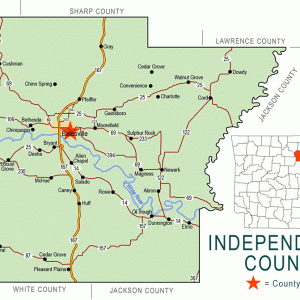 Independence County Map
Independence County Map 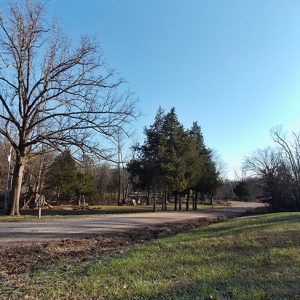 Walden Road
Walden Road 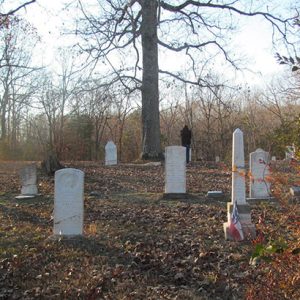 Walnut Grove Cemetery
Walnut Grove Cemetery 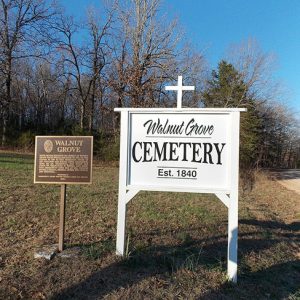 Walnut Grove Cemetery
Walnut Grove Cemetery 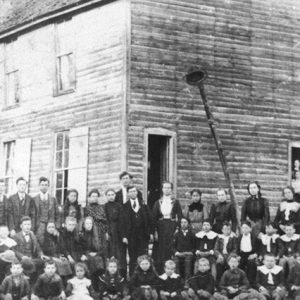 Walnut Grove School
Walnut Grove School 




Comments
No comments on this entry yet.